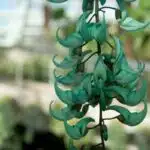Corkscrew vine, also known as Vigna Caracalla or snail vine, is a stunning plant that belongs to the family Fabaceae. It is native to South America and is popular among gardeners for its beautiful flowers and unique twisted stems that resemble corkscrews. Corkscrew vine is a climbing plant that can grow up to 20 feet in height and requires proper care to thrive.
In this article, we will provide you with detailed instructions on how to grow and care for corkscrew vine in your own garden. We will cover everything from selecting the right soil and location to pruning and fertilizing techniques. Whether you are an experienced gardener or just starting out, this guide will help you successfully cultivate this stunning plant and enjoy its beauty for years to come. So, let’s dive into the world of corkscrew vine and discover how you can create a beautiful garden with this unique plant!
Understanding The Corkscrew Vine Plant
Corkscrew vine is a unique and attractive plant that belongs to the Bignoniaceae family. It is native to South America, where it grows as a vigorous climber in the tropical rainforests. The plant’s growth pattern is characterized by long, thin stems that twine around any support they find. Its leaves are pinnate with 5-7 leaflets, which are glossy green and elongated.
The corkscrew vine plant can grow up to 30 feet tall if given the right conditions. It produces clusters of tubular-shaped flowers that are pinkish-purple in color and have a delightful fragrance. These blooms appear in late spring or early summer and continue until fall, attracting hummingbirds and bees. The plant’s seeds are flat and winged, making them easy to disperse by wind.
The best climate for growing corkscrew vine plants is warm and humid with plenty of sunshine. They require well-drained soil with a pH range of 6-7.5, but they can adapt to various soil types as long as they receive enough water during their growing season. To ensure successful cultivation, it is essential to provide proper care, including regular watering, fertilization, pruning, and pest control measures. With these tips in mind, you can enjoy the beauty of this unique plant in your garden or home landscape. In selecting the right soil for your corkscrew vine plant, several factors need consideration to provide optimal conditions for growth and development.
Selecting The Right Soil For Your Corkscrew Vine
Understanding the Corkscrew Vine Plant is crucial in ensuring that you provide the right environment for it to thrive. Now that we have a basic understanding of this plant, let us move on to the soil composition and drainage requirements for your corkscrew vine.
Soil composition plays a vital role in the growth and development of your corkscrew vine. It is important to select soil that has good drainage and aeration. The ideal soil should be well-draining but able to retain moisture for extended periods. You can achieve this by mixing sand, loam, peat moss, and perlite or vermiculite in equal parts. This will create a porous mixture that provides oxygen to the roots and allows excess water to drain away.
Drainage requirements are also essential when it comes to caring for your corkscrew vine. The roots of this plant are susceptible to rot if they sit in waterlogged soil for an extended period. Make sure that you choose a pot with drainage holes or place stones at the bottom of your container before adding soil. This will ensure that any excess water drains away from the roots, preventing root rot.
To summarize, choosing the right soil composition and ensuring proper drainage requirements are crucial when it comes to growing and caring for your corkscrew vine. Remember, providing an optimal environment will not only promote healthy growth but also prevent diseases caused by poor soil quality or improper watering techniques. In our next section, we will discuss how to choose the right location for your corkscrew vine so that it can receive adequate sunlight and thrive in its new home.
Choosing The Right Location For Your Corkscrew Vine
When choosing a location for your corkscrew vine, it is important to consider the amount of sun exposure and wind tolerance that the plant requires. Corkscrew vines thrive in areas with full sunlight but can also grow in partially shaded areas. However, if planted in an area with too much shade, the plant may not produce as many flowers as it would with more sunlight.
In addition to sun exposure, it is important to consider the wind tolerance of your corkscrew vine. These plants are relatively hardy and can withstand moderate winds, but they may suffer damage if they are exposed to constant strong winds or gusts. It is recommended that you choose a location that is somewhat sheltered from strong winds while still allowing for adequate air circulation.
Overall, selecting a suitable location for your corkscrew vine involves finding a balance between sunlight and wind protection. By providing sufficient sun exposure and protecting the plant from excessive wind, you can create an environment where your corkscrew vine can flourish and produce beautiful blooms for years to come.
Transitioning into the subsequent section about planting your corkscrew vine, it is important to prepare the soil properly before planting to ensure optimal growth conditions.
Planting Your Corkscrew Vine
When planting your corkscrew vine, it is important to choose the right location. This plant thrives in full sun to partial shade and requires well-draining soil. You can plant it directly in the ground or in a container for easier maintenance.
If you opt for container gardening, select a pot with good drainage holes and fill it with a high-quality potting mix. Choose a pot that is at least twice the size of the plant’s root ball to allow room for growth. Keep in mind that corkscrew vine grows rapidly and may require a larger container as it matures.
To complement your corkscrew vine, consider planting some companion plants nearby. Some of the best companion plants include morning glory, moonflower, and black-eyed Susan vines. These plants not only add visual interest but also attract beneficial pollinators like bees and butterflies to your garden. With proper planting and care techniques, your corkscrew vine will flourish alongside its companions.
As you move on to watering your corkscrew vine, keep in mind that this plant prefers consistently moist soil but does not tolerate standing water. It is important to let the top inch of soil dry out slightly between waterings to prevent overwatering and root rot. By following these guidelines, you can help ensure a healthy and thriving corkscrew vine in your garden or container.
Watering Your Corkscrew Vine
Imagine coming home after a long day at work and seeing your corkscrew vine looking droopy and sad. This is a common sight for those who do not properly water their plant. It’s important to understand the watering needs of your corkscrew vine in order to keep it healthy and thriving.
Watering frequency for your corkscrew vine will depend on various factors such as temperature, humidity, and soil moisture. During the hot summer months, you may need to water your plant more frequently than during cooler seasons. The key is to avoid overwatering as this can lead to root rot. Check the soil moisture by sticking your finger into the soil about an inch deep – if it feels dry, it’s time to water your plant.
In addition to checking soil moisture regularly, it’s important to ensure proper drainage for your corkscrew vine. Make sure that the pot has drainage holes at the bottom and that excess water can escape easily. You can also add a layer of rocks or pebbles at the bottom of the pot to improve drainage. By following these watering tips, you can help ensure that your corkscrew vine thrives for years to come.
Now that we’ve covered watering frequency and soil moisture for your corkscrew vine, let’s move on to fertilizing this beautiful plant. Fertilizing provides essential nutrients that promote growth and health in plants. With proper fertilization techniques, you’ll be able to enjoy a vibrant and flourishing corkscrew vine in no time!
Fertilizing Your Corkscrew Vine
Fertilizing your corkscrew vine is crucial to maintaining a healthy and vibrant plant. When it comes to fertilizers, you have two options: organic or chemical. Organic fertilizers are derived from natural materials, such as compost or animal manure. Chemical fertilizers, on the other hand, are synthesized in a lab and contain concentrated nutrients.
Organic fertilizers offer numerous benefits for your corkscrew vine. They release nutrients slowly, which allows for consistent growth over time. Additionally, they improve soil quality by increasing microbial activity, which helps retain moisture and prevents erosion. Chemical fertilizers may provide a quick boost of nutrients but can also lead to over-fertilization and nutrient imbalances if not used correctly.
The frequency of fertilization depends on the type of fertilizer you choose and the specific needs of your corkscrew vine. Generally, organic fertilizers should be applied every 4-6 weeks during the growing season. Chemical fertilizers should be used less frequently, usually every 6-8 weeks. Be sure to follow the instructions on the package carefully to avoid over-fertilization, which can damage your plant’s roots and leaves.
When it comes to pruning your corkscrew vine, timing is key. It’s best to prune in late winter or early spring before new growth begins. Pruning helps shape the plant and encourages healthy growth by removing dead or damaged branches. It also promotes flowering by allowing more light and air circulation throughout the plant. However, don’t go overboard with pruning as it can reduce blooming potential for the current year’s growth.
Pruning Your Corkscrew Vine
As a plant specialist, I highly recommend that you prune your corkscrew vine regularly to encourage healthier growth and more vibrant blooms. Pruning techniques can vary depending on the age of the plant and its current state. When pruning your corkscrew vine, it is important to remember that timing is everything. You should always prune your vine during winter or early spring before new growth begins.
To ensure that your corkscrew vine produces optimal blooms, remove any dead or damaged branches first. Then, begin thinning out any overcrowded areas of the plant. Be sure to cut back any branches that are growing too vigorously or in unwanted directions. When pruning, try to keep the overall shape of the plant in mind to maintain its aesthetic appeal.
When it comes to pruning your corkscrew vine, there are a few key things you should keep in mind:
- Always use sharp pruning shears to prevent damaging the plant
- Avoid cutting into any new growth as this can stunt the plant’s development
- Cut at an angle above a healthy bud or branch junction for optimum results
By following these simple guidelines and adopting proper pruning techniques, you will be able to enjoy a healthy and thriving corkscrew vine for years to come.
Transitioning into training your corkscrew vine to climb, it is important to understand how pruning plays a crucial role in this process.
Training Your Corkscrew Vine To Climb
Corkscrew vines are known for their ability to climb and coil around various structures, which makes them a great addition to gardens and landscapes. However, it is important to train them properly so that they grow in the desired direction and do not become unmanageable. There are many training techniques available for corkscrew vines, but two of the most popular ones include tying and pruning.
Tying is a simple technique that involves using garden twine or wire to secure the vine to a trellis or other structure. This will help guide the vine in the desired direction as it grows. It is important to use soft ties such as twine instead of harsh materials like wire, which can damage the stem of the plant. Pruning is another effective method of training corkscrew vines. This involves removing unwanted stems and leaves from the plant in order to promote growth in certain areas.
When it comes to trellis options, there are numerous choices available depending on your preference and space limitations. A common trellis option for corkscrew vines is an arbor, which provides ample space for the plant’s growth while also creating an attractive focal point in your garden. Other options include wall-mounted trellises, teepees, and tripods. Whatever trellis you choose should be sturdy enough to support the weight of a mature corkscrew vine while also allowing room for air circulation around the plant.
As with any plant, proper care is essential for healthy growth and development. In the next section, we will discuss how to deal with pests and diseases that may affect your corkscrew vine so that you can ensure its continued success in your garden or landscape.
Dealing With Pests And Diseases
As with any plant, corkscrew vines are susceptible to pests and diseases. These can range from common garden pests such as aphids, spider mites, and whiteflies to more severe issues like powdery mildew and fungal infections. It’s essential to keep an eye out for any signs of infestation or disease, as catching them early is crucial in preventing further damage.
One natural remedy for dealing with pests is neem oil. This organic solution is derived from the neem tree and is effective against a wide range of insects. Simply mix a few drops of neem oil with water in a spray bottle and apply it to the affected areas of your corkscrew vine. Alternatively, you can use insecticidal soap or a mixture of water and dish soap to combat pests.
For more severe pest or disease problems that cannot be solved with natural remedies, it may be necessary to call in professional pest control services. These experts have access to specialized treatments that can effectively eliminate even the most stubborn infestations. If you suspect your corkscrew vine has a serious issue, don’t hesitate to seek out professional help.
When it comes to keeping your corkscrew vine healthy and thriving, prevention is key. Regularly inspecting your vine for any signs of trouble and taking steps to address these issues promptly will go a long way in ensuring its longevity. In the next section, we will discuss how you can propagate your corkscrew vine to grow even more of these beautiful plants.
Propagating Your Corkscrew Vine
After carefully tending to your corkscrew vine and ensuring it is healthy and pest-free, you may want to consider propagating the plant. Plant propagation refers to the process of creating new plants from existing ones, either through seeds or cuttings. In the case of corkscrew vines, propagation through stem cuttings is a common method.
To propagate your corkscrew vine through stem cuttings, start by selecting a healthy stem without any flowers or buds. Cut the stem at an angle using sharp pruning shears, making sure it is about 4-6 inches long. Remove any leaves from the bottom half of the stem and dip it in rooting hormone. This will help stimulate root growth. Place the cutting in a pot with well-draining soil and water thoroughly.
It may take several weeks for the cutting to develop roots and start growing into a new plant. Keep the soil moist but not too wet during this time to avoid rotting. Once you see new growth on your cutting, you can transplant it into its own pot or directly into your garden. By propagating your corkscrew vine, you can expand your collection or share this beautiful plant with others who appreciate its unique qualities.
Transition: Now that you have successfully propagated your corkscrew vine, it’s important to know how to overwinter it to ensure its survival during colder months.
Overwintering Your Corkscrew Vine
Picture this: You have nurtured your corkscrew vine all summer long, and it has become a beautiful addition to your garden with its twisted vines and unique flowers. However, winter is coming, and you need to protect your plant from the harsh weather conditions. Much like a mother bird protecting her nest, you must take measures to ensure your corkscrew vine’s survival during the winter months.
Protecting roots is essential for overwintering corkscrew vines successfully. Start by removing any excess foliage that may be left on the plant before the first frost arrives. This will prevent any potential diseases or pests from taking hold of the plant during dormancy. Then, add a thick layer of mulch around the base of the plant, covering it entirely. This will insulate the roots and keep them warm during cold weather conditions.
Winter care for corkscrew vines should also involve monitoring moisture levels closely. While overwatering can lead to root rot and other problems, underwatering can cause significant damage as well. It is crucial to keep soil moist but not waterlogged throughout winter by watering once every two weeks or as needed depending on local climate conditions. By following these steps, you can ensure that your corkscrew vine will survive the winter months and thrive again come springtime.
As we’ve discussed in detail how to overwinter your corkscrew vine successfully, now let’s talk about using corkscrew vine in landscaping. With its unique shape and stunning flowers, it makes an excellent choice for vertical gardening or as a ground cover in garden beds or borders. Moreover, it thrives in full sun or partial shade areas with medium moisture soils that are well-drained; therefore, adding this plant to your landscape design will bring years of enjoyment and beauty to your outdoor space without much maintenance effort!
Using Corkscrew Vine In Landscaping
After successfully overwintering your corkscrew vine, it is time to incorporate it into your garden or landscape. One way to showcase its unique and intriguing appearance is by planting it on a corkscrew vine trellis. This will allow the plant to twist and turn, drawing attention to its distinct curvy stems. Choose a sturdy trellis that can support the weight of the plant as it grows.
Another way to incorporate corkscrew vine into your garden is by adding it to a mixed border. Plant it with other vines, such as morning glories or sweet peas, for a colorful display of different textures and shapes. The corkscrew vine’s unusual form will add an interesting dimension to any garden design. Be sure to plant in well-drained soil and provide adequate water and sunlight.
In addition to its ornamental value, harvesting corkscrew vine seeds can be a fun activity for the avid gardener. Wait until the seed pods have dried out before collecting them. Gently break open the pods and separate the seeds from the fluff. Store them in a cool, dry place until ready for planting next season. With proper care and maintenance, your corkscrew vine will continue to thrive and bring interest to your garden year after year.
Harvesting Corkscrew Vine Seeds
The corkscrew vine is a unique and beautiful plant that can add character to any garden. While its twisted tendrils and vibrant flowers are its most striking features, the plant also produces seeds that can be collected and used for future growth. Harvesting these seeds is a simple process that can be done with minimal effort.
Once the corkscrew vine has bloomed, it will begin to produce seed pods. These pods can be harvested when they turn brown and dry out. To collect the seeds, simply remove the pods from the plant and break them open to reveal the small black seeds inside. It’s important to do this before the pods burst open on their own, as this can scatter the seeds over a wide area.
Storing seeds is key to ensuring their viability for future use. Once you have collected your corkscrew vine seeds, store them in an airtight container in a cool, dry place until you are ready to use them. When you’re ready to germinate your seeds, soak them in water for 24 hours before planting them in well-draining soil. With proper care and attention, your corkscrew vine will grow strong and healthy, adding beauty and character to your garden for years to come.
Transition: Now that you know how to harvest and store corkscrew vine seeds, it’s time to learn how to create a beautiful garden with this unique plant species.
Creating A Beautiful Garden With Corkscrew Vine
Corkscrew vine is a stunning plant that can add a unique touch to any garden. It’s an excellent option for creating vertical gardens, as it grows quickly and can reach up to 30 feet in height. When growing corkscrew vine, it’s essential to provide it with plenty of sunlight and well-draining soil. If you live in an area with hot summers, make sure to water your corkscrew vine regularly.
Combining corkscrew vine with other plants can create a beautiful garden that will impress anyone who sees it. One excellent option is to pair it with morning glories or moonflowers, which bloom at night and will look lovely alongside the corkscrew vine’s twisting tendrils. Another great idea is to grow corkscrew vine on a trellis or arbor and pair it with climbing roses. This combination will create a charming and romantic atmosphere in your garden.
Incorporating corkscrew vines into your garden is an excellent way to add beauty and interest to your outdoor space. Whether you’re creating a vertical garden or pairing it with other plants, this unique plant is sure to impress. With proper care and attention, you’ll be rewarded with a stunning display of foliage that will bring joy to you and those around you. In the next section, we’ll discuss some common issues that may arise when caring for corkscrew vines so that you can keep your plants healthy and thriving.
Troubleshooting Common Issues With Corkscrew Vine
Oh, the joys of being a plant parent! You did your research, prepared the soil, and lovingly planted your corkscrew vine. But now, you find yourself dealing with some common issues that are preventing it from flourishing. Don’t worry, every plant parent goes through this phase.
One issue with corkscrew vines is wilting. This can happen due to several reasons such as under or overwatering, poor soil drainage, or extreme temperatures. To prevent wilting, ensure that you water your vine thoroughly but avoid waterlogging the soil. Also, make sure the pot has adequate drainage holes to allow excess water to escape. If your plant is exposed to direct sunlight or harsh winds, consider moving it to a shadier spot.
Another common issue is stunted growth or yellowing leaves. This could be caused by insufficient light or nutrients in the soil. Ensure that your vine gets enough sunlight and add organic fertilizers such as compost or aged manure to promote healthy growth. Additionally, check for any pests or diseases like spider mites and powdery mildew which can also affect plant health.
In conclusion (just kidding!), caring for a corkscrew vine requires patience and attention to detail. By preventing wilting and promoting healthy growth through proper watering techniques and nutrient-rich soil, you can help your vine thrive. With these tips in mind and a little extra care, you’ll soon have a beautiful and healthy corkscrew vine gracing your home or garden space!
4 Tips for Promoting Healthy Growth:
- Ensure proper drainage by using pots with adequate holes.
- Water thoroughly but avoid waterlogging the soil.
- Add organic fertilizers like compost or aged manure.
- Check for pests or diseases regularly and take appropriate action if necessary.
Conclusion
The Corkscrew Vine is a magnificent plant that can add a touch of elegance to any garden. Understanding the unique features and requirements of this plant is essential for its proper care and growth. From selecting the right soil to harvesting seeds, every aspect of caring for the Corkscrew Vine requires careful consideration.
The Corkscrew Vine’s twisting stems and delicate flowers make it an excellent choice for landscaping projects. Its ability to thrive in a variety of soils and climates makes it an adaptable addition to any garden or landscape design. Proper watering techniques are crucial for maintaining optimal growth, along with regular pruning and fertilization.
In conclusion, the Corkscrew Vine is a beautiful, versatile plant that can enhance any garden or landscape design. With proper care and attention, this plant can flourish into a stunning centerpiece that will delight all who see it. As horticultural specialists, we must continue to explore new ways to incorporate this lovely plant into our designs and appreciate its unique beauty in all seasons.
Image Credits

![How To Grow And Care For Corkscrew Vine 1 Strophanthus preussii [Corkscrew Flower, Poison Arrow Vine, Spider Tresses, Tassel Vine] Apocynaceae](https://green-life.blog/wp-content/uploads/2023/04/KW5aFOG5S3jq.jpg.webp)



























